Understanding Shower Head Installation Costs for Trade Professionals
For construction professionals, accurately estimating the cost of installing a shower head is crucial. In 2025, typical costs range from $150 to $425 for a basic swap-out, while full upgrades can reach $1,200. This guide breaks down the factors influencing these costs and offers insights into optimizing estimates for trade professionals.
Key Cost Factors in Shower Head Installation
- Component Cost: Standard chrome heads start at $25, while rain or smart heads range from $150 to $400.
- Rough-in Condition: Solid existing plumbing reduces labor time, while corroded lines increase costs.
- Valve Upgrades: Transitioning to a pressure-balancing valve can add $250–$500.
- Tile or Drywall Repair: Accessing supply lines may add $150–$300 for repairs.
- Labor Rates: Average rates in Austin are $85–$110 per hour, with complex installs taking 3–6 hours.
Typical Price Ranges for Professional Installations
- Basic swap-out: $150–$275 (includes fixture under $60)
- Premium multifunction or rain shower head: $275–$425
- New valve and upgraded supply arm: $600–$900
- Full remodel with ceiling-mount rainfall head: $900–$1,200+
Why Costs Vary Between Projects
Each project has unique challenges. Older homes may require line replacements, while newer builds might only need simple swaps. Accurate estimates consider these variables, ensuring precise budgeting.
DIY vs. Professional Installation
- DIY is feasible for simple swaps with the right tools.
- Professional services are recommended for complex installations to avoid costly mistakes.
Optimizing Estimates with Technology
Utilize AI-driven tools to streamline the estimation process, ensuring accurate and competitive pricing for your clients.
Pro Tips for Cost-Effective Installations
- Purchase fixtures through trade suppliers for discounts.
- Schedule installations mid-week to avoid premium rates.
- Combine tasks to save on labor costs.
- Consider water-efficient fixtures for long-term savings.
Advanced Considerations for Shower Head Installations
Understanding the compatibility of fixtures with existing plumbing is essential to avoid cost overruns. This section provides insights into ensuring seamless installations.
Flow Rate Compatibility
- Standard 2.5 GPM heads are compatible with 1/2-inch copper lines.
- Rainfall panels may require larger lines, impacting costs.
Valve Selection
- Pressure-balancing valves prevent temperature fluctuations and add around $180 to costs.
- Thermostatic valves offer precise control, adding $320–$450 to the budget.
Water Quality Considerations
- Hard water can cause build-up; consider silicone nozzle heads for durability.
- Inline filters can be added for $40, improving water quality.
Ensuring Quality and Accountability
Track installations with photo checkpoints to ensure quality and adherence to specifications, minimizing the risk of costly errors.

